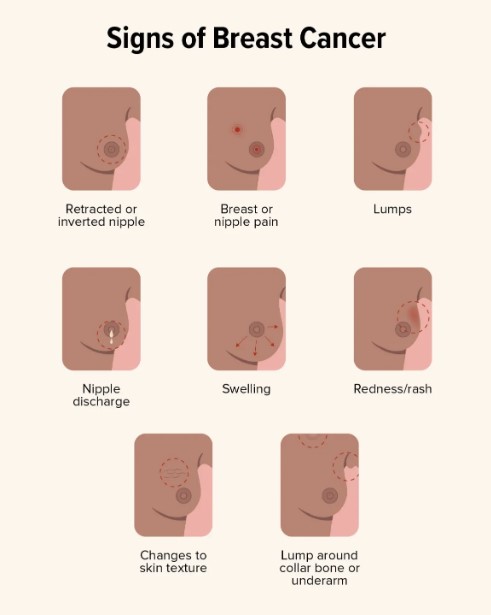Breast cancer typically remains asymptomatic in its early stages, but early detection can transform a breast cancer diagnosis into a tale of survival.
The most prevalent initial symptom is the presence of a breast lump, although approximately one in six women with breast cancer do not experience this symptom.
In this article, we will delve into the early indicators and signs of breast cancer, the subsequent steps in the diagnostic process, and where to seek support.
Initially Warning Signs of Breast Cancer:

Early Symptoms of Breast Cancer:
Early on, individuals may notice changes in their breasts during self-examinations or persistent, unexplained minor discomfort. Initially signs to be vigilant for include:
- Alterations in nipple shape.
- Ongoing breast pain beyond one’s menstrual cycle.
- The persistence of a new lump beyond one’s menstrual cycle.
- Nipple discharge from a single breast, which may be clear, red, brown, or yellow.
- Unexplained redness, swelling, skin irritation, itching, or rash on the breast.
- Swelling or a lump near the collarbone or beneath the arm.
A lump with a firm texture and irregular borders is more likely to be cancerous.
Advanced Symptoms of Breast Cancer:
Advanced signs of breast cancer encompass:
- Nipple retraction or inward turning.
- Enlargement of one breast.
- Dimpling of the breast surface.
- An existing lump growing in size.
- A skin texture resembling an orange peel.
- Decreased appetite.
- Unintentional weight loss.
- Enlarged lymph nodes in the armpit.
- Visible veins on the breast.
Experiencing one or more of these symptoms does not definitively indicate breast cancer, as conditions like infection can also cause nipple discharge. Consulting a healthcare professional for a comprehensive evaluation is crucial if any of these signs or symptoms arise.
Defining a “Normal” Breast:
Each person’s breast is unique, and there is no universal definition of a “normal” breast. The concept of normality refers to how one’s breasts typically appear and feel, as well as the significance of any changes.
It is important to note that breast changes may occur during ovulation due to increased fluid retention, resulting in:
- Swelling.
- Tenderness or soreness.
- Pain.
- Lumpiness.
These symptoms should resolve after the onset of menstruation.

Breast Self-Examinations:
Regular self-examinations facilitate familiarity with one’s breast’s usual appearance and texture, enabling the early detection of changes. Here is what to observe:
- Discrepancies in overall breast size, shape, or color.
- Dimpling or protrusions on the skin.
- Redness, tenderness, rash, or swelling.
- Nipple inversion or unusual discharge.
To conduct a breast self-exam:
- Stand before a mirror with shoulders straight and hands on hips to visually inspect your breasts.
- Repeat with arms raised.
- Lie down on your back to palpate your breasts. Utilize the pads of your fingers, moving in a circular motion to detect lumps or alterations. Cover the entire breast area, from the chest’s center to the armpit and from the abdomen to the collarbone.
- Repeat this process using your left hand to examine your right breast.
- Examine while standing or sitting, possibly during a shower for added ease.
Are Breast Lumps Typically Cancerous?
While breast lumps are often associated with breast cancer, the majority are benign. Approximately 75 percent of breast biopsies yield benign breast disease diagnoses.
Common benign causes of breast lumps include:
- Breast infection.
- Fibrocystic breast disease is often known as “lumpy breasts.”
- Fibroadenoma is a noncancerous tumor.
- Fat necrosis, which involves damaged tissue.
Distinguishing fat necrosis from a cancerous lump requires a biopsy. Nonetheless, despite the prevalence of less severe conditions causing breast lumps, new, painless lumps remain the most common symptom of breast cancer.
Other Causes of Breast Pain and Tenderness:
Breast pain, clinically termed mastalgia, is rarely the initial noticeable sign of breast cancer. Several factors can contribute to breast tenderness or pain, including:
- Hormonal fluctuations during menstruation.
- Specific birth control pills.
- Some fertility treatments.
- Ill-fitting bras.
- Breast cysts.
- Large breasts are often accompanied by neck, shoulder, or back pain.
- Stress.
Types of Breast Cancer:
Breast cancer is categorized into two primary types based on its nature:
- Noninvasive (in situ) cancer: This type does not extend beyond the original tissue and is referred to as stage 0.
- Invasive (infiltrating) cancer: This cancer spreads to neighboring tissues and is categorized as stages 1, 2, 3, or 4, depending on the extent of its spread.
The specific type of cancer is determined by the affected tissue, such as:
- Ductal carcinoma: Developing in the milk duct lining, this is the most prevalent type.
- Lobular carcinoma: Affecting the lobules responsible for milk production.
- Sarcoma: Originating in the breast’s connective tissue.
- Angiosarcoma: Emerging from cells lining blood vessels or lymph vessels.
Breast cancer can also be distinguished by certain characteristics, even though early signs and symptoms may be similar. These characteristics include:
- Hormone-positive breast cancer: Fueled by estrogen and/or progesterone.
- HER2-positive breast cancer: Characterized by elevated levels of the HER2 protein, promoting cancer cell growth.
- Triple-negative breast cancer: Testing negative for estrogen and progesterone receptors and HER2.
- Papillary breast cancer: Under microscopic examination, this type exhibits small, finger-like growths called papules, with both invasive and noninvasive cells.
- Metaplastic breast cancer: Often triple-negative, it may contain abnormal ductal cells alongside other cell types not typically found in the breast, like skin or bone cells.
Certain breast cancer types may present symptoms other than a breast lump:
- Inflammatory breast cancer: Characterized by blocked lymph vessels causing breast skin swelling, redness, and inflammation.
- Paget’s disease of the breast: Developing around the nipple and areola, leading to changes, discharge, nipple flattening or inversion, and potential blood or yellow discharge, accompanied by burning or itching.
- Metastatic breast cancer: This occurs when breast cancer spreads to distant body parts, resulting in symptoms like weight loss, unexplained pain, and fatigue.

Male Breast Cancer:
Although male breast cancer is relatively rare, it can occur at any age, primarily affecting older men. Contrary to common perception, breast cells exist in everyone, and they can undergo cancerous changes. Male breast cells being less developed than female counterparts contributes to the lower occurrence of breast cancer among men.
The most prevalent symptom of male breast cancer is a lump within the breast tissue. Additional symptoms may encompass:
- Thickening of breast tissue.
- Nipple discharge.
- Redness or scaling of the nipple.
- Nipple retraction or inversion.
- Unexplained redness, swelling, skin irritation, itching, or rash on the breast.
- Swollen lymph nodes beneath the arm.
Given that men may not regularly conduct breast self-examinations, male breast cancer is often diagnosed at later stages.
Diagnosing Breast Cancer:
When individuals seek medical attention due to breast pain, tenderness, or a lump, healthcare providers typically employ the following diagnostic procedures:
- Physical examination: This involves a thorough assessment of the breasts, nipple condition, discharge, and palpation to detect lumps or abnormalities in the breast and armpit areas.
- Medical history: Healthcare providers gather information about the individual’s health history, medication usage, and family history of breast cancer, as genetic factors can play a role. Symptoms, including their onset, are also discussed.
- Mammogram: An X-ray of the breast assists in distinguishing benign and malignant masses.
- Ultrasound: Utilizing ultrasonic sound waves, this imaging method produces images of breast tissue.
- MRI: Magnetic resonance imaging may be recommended alongside other tests for a comprehensive breast tissue examination.
- Biopsy: The removal of a small sample of breast tissue for laboratory testing remains the sole method to definitively confirm a breast cancer diagnosis.
Treating Breast Cancer:
Treatment for breast cancer varies depending on cancer type and stage. Common treatment modalities encompass:
- Lumpectomy: Surgically removing the tumor while preserving the breast.
- Mastectomy: Surgical removal of all breast tissue, including the tumor and surrounding tissue.
- Chemotherapy: Employing anticancer drugs that interfere with cell reproduction, commonly used in cancer treatment.
- Radiation: Directing radiation beams at the cancer to treat it locally.
- Hormone and targeted therapy: Administered when hormones or HER2 contribute to cancer growth.
Signs and Symptoms of Breast Cancer Recurrence:
Despite successful initial treatment, breast cancer can recur when a small number of cells evade the initial therapy. Symptoms of a recurrence are akin to those of the initial breast cancer and may encompass:
- The emergence of a new breast lump.
- Changes in nipple appearance.
- Redness or swelling of the breast.
- New thickening near the mastectomy scar.
If breast cancer recurs in the same area as the original cancer, the symptoms closely resemble those of the initial cancer. However, if it recurs regionally, indicating its return to lymph nodes or nearby regions, the symptoms may differ slightly:
- Lumps in lymph nodes under the arm or near the collarbone.
- Chest pain.
- Arm or shoulder pain or sensory changes.
- Swelling in the arm on the same side as the initial breast cancer.
It’s essential to consult a healthcare professional when you observe any of these symptoms, even if you’ve undergone mastectomy or related breast cancer surgery, as scar tissue could lead to lumps or bumps that need monitoring.

Breast Cancer Outlook and Prevention:
The prognosis for breast cancer largely hinges on early detection and prompt treatment. In its early stages, breast cancer is highly treatable and often curable.
Breast cancer stands as the most prevalent cancer among women, according to the World Health Organization. To combat breast cancer, staying informed about risk factors and recognizing warning signs is crucial. Early detection through regular breast cancer screenings should be discussed with a healthcare provider.
Individuals experiencing breast pain or tenderness that raises concerns should schedule an appointment with a doctor. In the event of discovering a breast lump, regardless of a prior normal mammogram, prompt medical evaluation is recommended.
Finding Support When Living with Breast Cancer:
Learning of a breast cancer diagnosis can be overwhelming, but support is readily available. Connecting with others who have experienced or are currently facing similar challenges can be valuable.
Oncologists and treatment centers can guide individuals toward local resources, including support groups tailored to their needs. Numerous support groups and organizations provide various forms of assistance. Source By-https://en.wikipedia.org/wiki/Cancer_signs_and_symptoms


